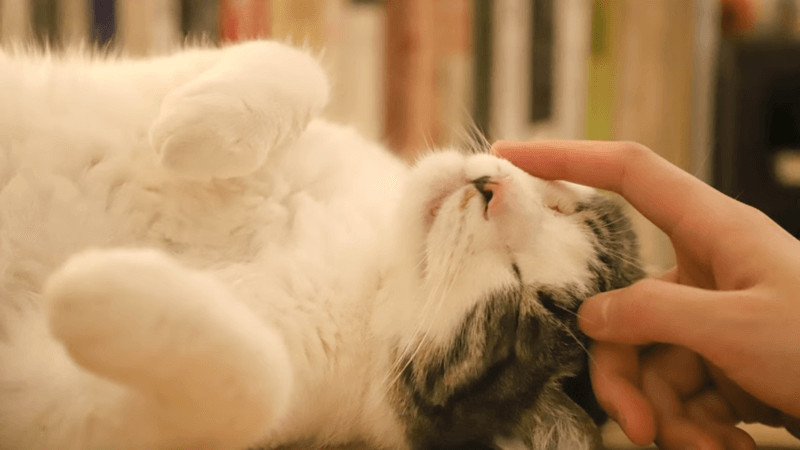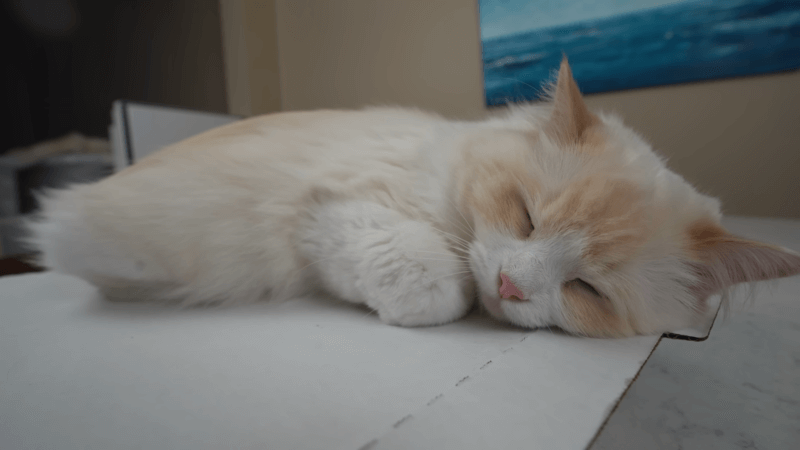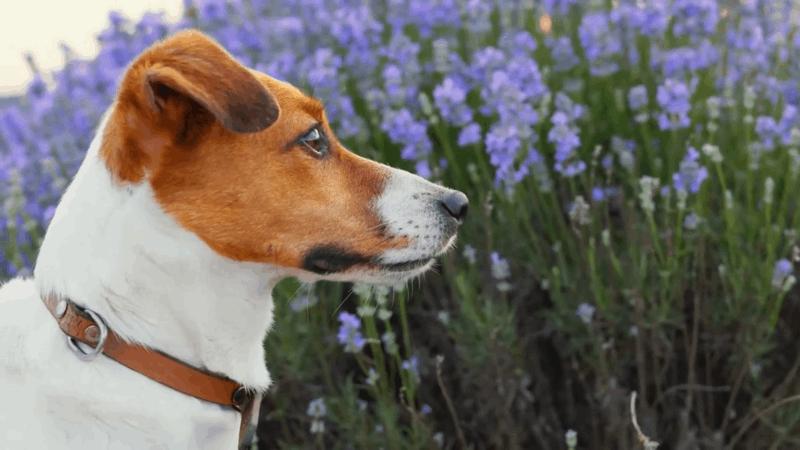No products in the cart.
The question of cat CBD for anxiety during thunderstorms has become a focal point of concern and curiosity among pet lovers. When thunderstorms roll in, the booming thunder, flashes of lightning, and atmospheric changes can transform even the most composed feline into a bundle of nerves. In the quest for a solution, cat owners are increasingly turning to CBD, short for cannabidiol, to alleviate their cats’ thunderstorm-induced anxiety. In this blog, we’ll explore the world of cat CBD for anxiety during thunderstorms, what is cat thunderstorm anxiety, and how to calm a cat during a thunderstorm
Cat CBD for Anxiety During Thunderstorms
CBD, short for cannabidiol, has gained popularity as a potential remedy for various ailments in both humans and pets, including cats. When it comes to cats and thunderstorm anxiety, CBD is being explored as a natural and non-pharmaceutical option to alleviate their distress.
CBD interacts with the endocannabinoid system in mammals, including cats. This system plays a vital role in maintaining bodily balance and regulating stress and anxiety. When cats are exposed to stressful situations like thunderstorms, their endocannabinoid system can become imbalanced, leading to heightened anxiety. You could discover even more fantastic CBD pet items at Pet CBD Club.

Potential Benefits of CBD for Cats Include
- Anxiety Reduction: CBD may help alleviate anxiety, including separation anxiety, social anxiety, and anxiety triggered by thunderstorms.
- Pain Management: CBD oil for cats has anti-inflammatory properties and can provide relief from chronic pain conditions or discomfort resulting from injuries or surgeries.
- Seizure Control: Some studies suggest that CBD might be beneficial in managing epilepsy and seizure disorders in cats.
- Improved Appetite: Cats experiencing appetite loss due to illness or stress might benefit from CBD’s potential to stimulate their appetite.
- Nausea and Vomiting Relief: CBD may help alleviate nausea and vomiting in cats, especially those undergoing chemotherapy or dealing with gastrointestinal issues.
- Anti-Inflammatory Effects: CBD’s anti-inflammatory properties can aid in managing conditions like arthritis and inflammatory bowel disease in cats.
- General Well-Being: CBD may promote overall well-being by supporting the endocannabinoid system, which regulates various bodily functions.
How CBD May Affect a Cat’s Anxiety During Thunderstorms
CBD’s potential to alleviate a cat’s anxiety during thunderstorms stems from its interaction with the endocannabinoid system (ECS). The ECS plays a vital role in regulating stress, mood, and overall balance in the body.
During a thunderstorm, a cat’s ECS may become imbalanced due to the stress and fear triggered by the loud noises and atmospheric changes. CBD may help restore this balance by:
- Reducing Anxiety: CBD can interact with receptors in the brain and peripheral nervous system, which are involved in the regulation of fear and stress responses. By modulating these receptors, CBD may decrease anxiety levels in cats.
- Promoting Relaxation: CBD’s calming properties may help relax your cat, making them less reactive to the thunderstorm’s stimuli.
- Managing Physiological Responses: CBD may also help regulate physiological responses to stress, such as increased heart rate and rapid breathing, by modulating the autonomic nervous system.
Types of CBD Products Available for Cats
Several types of CBD products are available for cats, allowing pet owners to choose the most suitable option for their feline friends. Common CBD products for cats include:
- CBD Oil or Tinctures: These are liquid extracts of CBD that can be administered directly under a cat’s tongue or mixed with their food.
- CBD Capsules or Softgels: Pre-measured doses of CBD are enclosed in a capsule or soft gel, making it easy to give a precise amount to your cat.
- CBD Treats: CBD-infused cat treats are a tasty way to administer CBD. Cats often enjoy the flavor, making it a convenient option.
- CBD Topicals: These are creams or balms infused with CBD that can be applied to your cat’s skin or fur. They are often used for localized relief of skin issues or sore spots.
- CBD Isolate: This is a pure form of CBD, typically in a crystalline powder form. It can be added to your cat’s food or treats for precise dosing.
The Legality and Safety of Using CBD for Pets
The legality of using CBD for pets can vary depending on your location and local regulations. In many regions, CBD derived from hemp plants (with minimal THC content) is legal for use in pets, as long as it contains less than 0.3% THC. However, it’s essential to check your local laws and regulations before purchasing or using CBD products for your cat.
As for safety, CBD is generally considered safe for cats when administered in appropriate doses. However, it’s crucial to follow these safety guidelines:
- Consult with a Veterinarian: Always consult with a veterinarian before starting any CBD regimen for your cat. They can provide guidance on the right dosage and help ensure it’s a suitable option for your cat’s specific health needs.
- Choose High-Quality Products: Select CBD products from reputable manufacturers that provide third-party lab testing results to verify the product’s purity and potency.
- Start with a Low Dose: Begin with a low dose of CBD and monitor your cat’s response. Gradually increase the dosage if necessary, under your veterinarian’s guidance.
- Watch for Side Effects: While side effects are rare, monitor your cat for any adverse reactions, such as lethargy, diarrhea, or changes in appetite. If you notice any concerning symptoms, stop the CBD and consult your veterinarian.
- Store Safely: Keep CBD products out of reach of pets and children, as they can be harmful if ingested in large quantities.
What Is Cat Thunderstorm Anxiety
Cat thunderstorm anxiety, also known as storm phobia or thunderstorm phobia, is a condition in which cats experience significant fear and distress during thunderstorms. This anxiety is a form of noise aversion, where loud sounds, such as thunderclaps, lightning, and heavy rain, trigger fear and anxiety in cats. It can be a challenging and distressing experience for both cats and their owners.

Do Cats Get Scared of Thunderstorms
Yes, many cats get scared of thunderstorms. Thunderstorms are a common trigger for anxiety in cats due to several factors:
- Loud Noises: Thunderstorms produce sudden and loud noises, such as thunderclaps and lightning strikes, which can startle and frighten cats.
- Barometric Pressure Changes: Some cats are sensitive to changes in barometric pressure that occur before and during a storm, which can contribute to their anxiety.
- Electrical Activity: The visible lightning during a storm may also disturb cats, as they may perceive it as a threat.
- Environmental Changes: Storms often lead to other environmental changes, such as darkening skies, changes in temperature, and gusty winds, which can unsettle cats.
These factors combine to create a stressful environment that can trigger anxiety in cats during thunderstorms.
Common Signs of Cat Thunderstorm Anxiety
Cats express anxiety in various ways, and the signs of thunderstorm anxiety can vary from one cat to another. Some common signs of cat thunderstorm anxiety include:
- Hiding: Cats often seek out hiding spots during thunderstorms. This could be under furniture, in closets, or in any secluded area where they feel safer.
- Trembling or Shaking: Cats may physically tremble or shake in response to fear and anxiety caused by the storm.
- Excessive Vocalization: Some cats may yowl, meow, or make other loud vocalizations during a thunderstorm.
- Pacing: Cats may pace around the house nervously, unable to settle down.
- Excessive Grooming: Stress can lead to over-grooming in some cats.
- Loss of Appetite: Cats with thunderstorm anxiety may refuse to eat during a storm.
- Litter Box Issues: Some cats may urinate or defecate outside the litter box due to anxiety.
- Destructive Behavior: Anxiety can lead to destructive behavior, such as scratching furniture or attempting to escape through windows or doors.
- Salivating or Drooling: In severe cases of anxiety, some cats may exhibit excessive salivation or drooling.
- Aggression: A fearful cat may become aggressive if approached or handled during a thunderstorm.
The Importance of Addressing This Issue
Addressing cat thunderstorm anxiety is crucial for several reasons:
- Mental and Emotional Well-Being: Prolonged anxiety negatively affects a cat’s mental and emotional health, leading to behavioral problems that lower their overall quality of life.
- Physical Health: Anxiety and stress can lead to physical health issues like digestive problems, skin conditions, and a weakened immune system. Addressing anxiety prevents these health concerns.
- Safety Concerns: Anxious cats may engage in dangerous behavior during storms, risking accidents or injuries while trying to escape.
- Bond with Owner: Severe anxiety during thunderstorms can strain the human-animal bond as cats associate their owners with fear.
- Improved Quality of Life: Managing thunderstorm anxiety significantly enhances a cat’s quality of life, ensuring they feel safe and secure at home, even during storms.
- Preventing Long-Term Issues: Early intervention and effective management prevent the development of long-term behavioral problems, ensuring a happier and healthier cat.
How to Calm a Cat During a Thunderstorm
- Create a Safe Space: Designate a quiet, secure room with your cat’s essentials—bedding, toys, and possibly a litter box.
- Comforting Items: Place a familiar blanket or your clothing in their safe haven for added comfort.
- Curtains Closed: Minimize lightning visibility by shutting curtains or blinds.
- White Noise or Music: Play soft white noise or calming tunes to muffle thunder sounds.
- Safe Hiding: Ensure hiding spots are safe, like under furniture or in closets.
- Stay Calm: Project a calm demeanor to reassure your cat of safety.

Practical Tips for Creating a Safe Space for Your Cat
When creating a safe space for your cat, consider the following practical tips:
- Choose an Interior Room: Select an interior room without windows to minimize exposure to thunderstorm-related stimuli.
- Remove Hazards: Remove any potential hazards or toxic substances from the safe space to ensure your cat’s safety.
- Comfort Items: Place your cat’s favorite bedding, toys, and a scratching post in the safe space to make it a comfortable retreat.
- Litter Box Access: If your cat may be confined for an extended period, provide access to a litter box within the safe space.
- Accessibility: Ensure that your cat can enter and exit the safe space freely. Avoid locking them in if they prefer to come out.
- Identification: Ensure your cat is wearing proper identification, such as a collar with an ID tag and a microchip, in case they escape during the storm.
Behavior Modification Techniques
Behavior modification techniques can help desensitize and counter-condition your cat to the fear of thunderstorms over time. Here are some techniques:
- Gradual Exposure: Start with low-volume recorded thunderstorm sounds, gradually increasing volume in multiple sessions to help your cat adapt.
- Positive Associations: Reward your cat with treats, praise, and playtime during or after simulated thunderstorm sessions to create positive associations with the sounds.
- Desensitization: Introduce elements of a storm, such as simulated lightning (flickering lights) and recorded thunder, in a controlled environment to desensitize your cat to these stimuli.
- Consult a Professional: For a tailored plan, consult a professional animal behaviorist or trainer experienced in behavior modification to address your cat’s specific needs.
Conclusion
Exploring solutions like cat CBD for anxiety during thunderstorms is crucial for the well-being of your feline friend. By effectively managing their thunderstorm anxiety, you can provide relief from fear and stress, improve their mental and emotional health, and enhance their overall quality of life. Additionally, early intervention in addressing this issue not only ensures your cat’s immediate comfort but also prevents potential long-term behavioral problems, making it a responsible and caring approach to pet ownership.
I am Nelson Cooper, I pursue my passion for writing and my belief is that cats love humans. I enjoy traveling and have a deep appreciation for the beauty of nature, as well as a soft spot for animals, particularly cats.


